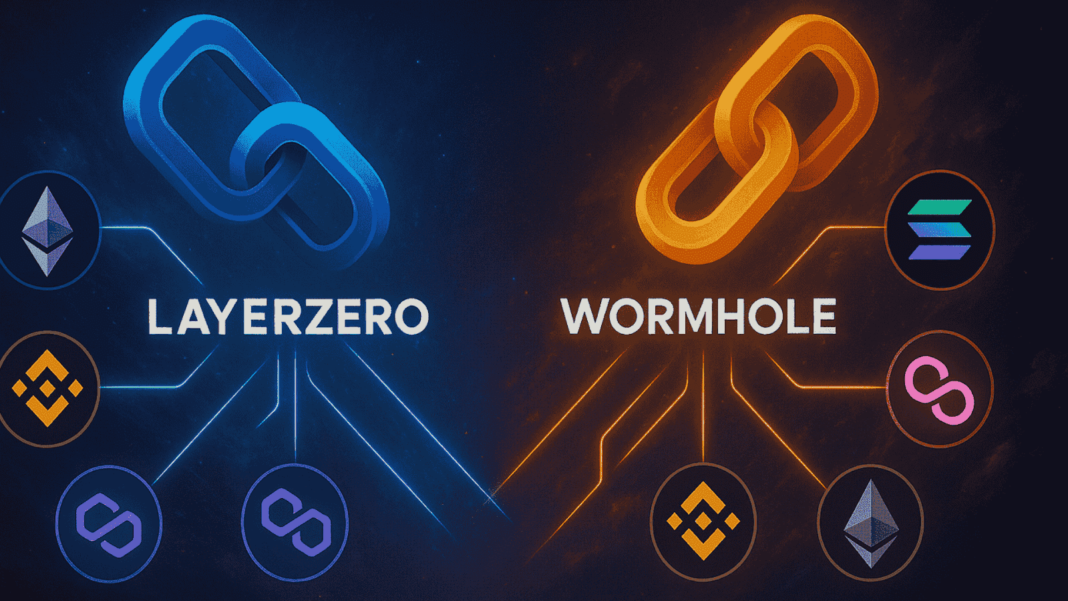July 26, 2025 — As the blockchain ecosystem has grown more diverse, fragmentation has become a major obstacle. Different chains offer unique features and communities—but liquidity and assets often become trapped, slowing user experience and limiting innovation. Two interoperability protocols, LayerZero and Wormhole, are taking different technical approaches to stitch these chains together. They’re forming the backbone of a more integrated, seamless Web3.
Blockchain Fragmentation: The Core Challenge
Blockchain fragmentation occurs when value and activity get siloed across isolated chains. Ethereum dominates DeFi, Solana attracts fast transaction volumes, BNB Chain remains cost-efficient, and newer appchains continue to appear. Without reliable messaging bridges, users and developers face friction in accessing liquidity across ecosystems. Transferring assets often requires complex bridging workflows or custodial trade models—slowing adoption and fragmenting liquidity pools.
LayerZero: A Lightweight Messaging Infrastructure
LayerZero is positioned as a foundational interoperability protocol—a messaging layer that treats each blockchain as a node in a universal network. It introduced the concept of Ultra-Light Nodes, simplifying trust models without requiring full node validation. That enables decentralized applications (OApps) to communicate cross-chain securely and efficiently.
Apps built on LayerZero—like Stargate and cross-chain DeFi aggregators—can move assets and messages in one seamless flow across blockchains. Developers retain control over which oracles and relayers they trust, reducing centralization risk.
LayerZero V2 builds on this foundation and adds support for non-EVM chains, expanding interoperability while preserving its lightweight design.
Wormhole: The Veteran Bridge with Broad Reach
In contrast, Wormhole (also known as Portal) uses a guardian-based approach. From Solana’s bridge roots to supporting over 30 chains today, Wormhole acts as a multi-chain messaging and token gateway. A network of guardians verifies transactions and issues Verifiable Action Approvals (VAAs) to update downstream contracts across networks.
Wormhole handles both tokens and NFTs, enabling governance coordination across chains and supporting data messaging applications. With over a billion cross-chain messages processed, it remains a core infrastructure piece in multi-chain ecosystems.
LayerZero vs. Wormhole: Technical Trade-Offs
The two protocols embody different design philosophies:
- LayerZero offers modular trust: developers choose relayers and oracles independently, increasing flexibility and minimizing systemic risk. Its architecture also emphasises scalability and low gas usage.
- Wormhole, backed by a guardian ecosystem, provides speed and ease of use—including NFT bridging and fast token transfers. However, it relies on a smaller validator set, which centralises risk.
Wormhole infamously suffered a $325 million exploit in 2022, exposing the vulnerability in guardian-based models. LayerZero has avoided such incidents to date—delivering billions in cross-chain value without loss.
Real-World Applications and Ecosystem Growth
LayerZero facilitates advanced cross-chain DeFi platforms, allowing users to move liquidity and messaging across chains in a composable flow. It powers applications such as Stargate and Radiant Capital, enabling cross-chain smart contract interoperability.
Wormhole’s broad reach makes it indispensable to gaming use cases, cross-chain DAO activity, and ecosystems needing NFT bridging. Its integration with stablecoins, wrapped tokens, and cross-chain governance reflects its adaptability.
Portfolio diversification tools, cross-chain DEXs, and multichain wallet infrastructure are relying on both protocols as they evolve toward unified UI and consistent messaging standards.
Looking Ahead: Interoperability’s Next Chapter
The future of cross-chain infrastructure likely involves standardization: protocol-agnostic messaging, threshold validation, and support for emerging standards like ERC‑4337 and other interoperability primitives. New protocols like Hyperlane, Axelar, and ZetaChain add depth to the space, pushing developers toward composability-first architectures.
Success will hinge on performance, usability, and economic sustainability. So far, LayerZero leads in multi-chain messaging volume; Wormhole remains a go-to for fast bridging. Each has carved out roles—but both align toward a unifying goal: making blockchain boundaries invisible to users.
Final Takeaway
LayerZero and Wormhole are helping redefine blockchain from isolated networks into interconnected infrastructure. Whether users need composable messaging, token bridging, DeFi interoperability, or NFT portability, these protocols deliver integrated interoperability models.
Choosing between them comes down to your design philosophy: LayerZero for modular trust and messaging breadth, Wormhole for fast cross-chain asset flows and multi-chain compatibility. Together, they are stitching the fractured chains of Web3 into a seamless blockchain fabric—enabling the promise of a truly omnichain ecosystem.

